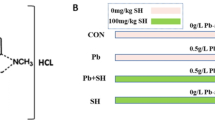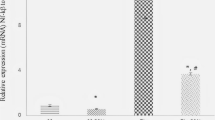Abstract
Lead (Pb) intoxication may initiate many disorders in human and animals. This study investigates the role of exogenous hydrogen peroxide (H2O2) in inducing mouse tolerance to Pb exposure. Results showed that the simultaneous application of 1.2 μg H2O2 per kg body weight efficiently protected mice against the Pb-caused injury, as revealed by decreased growth suppression caused by the Pb stress, increased antioxidative enzyme activity, reduced lipid peroxidation, and the protective effect on the nuclear DNA integrity. To our knowledge, this is the first finding of this sort.




Similar content being viewed by others
References
Aebi HE (1983) Catalase. In: Bergmeyer HU (ed) Methods of enzymatic analyses. Verlag Chemie, Weinheim, pp 273–282
Adonaylo VN, Oteiza PI (1999a) Pb2+ promotes lipid oxidation and alterations in membrane physical properties. Toxicology 132:19–32
Adonaylo VN, Oteiza PI (1999b) Lead intoxication: antioxidant defenses and oxidative damage in rat brain. Toxicology 135:77–85
Bechara EJH, Medeiros MHG, Monteiro HP, Hermes-Lima M, Pereira B, Demasi M, Costa CA, Abdalla DSP, Onuki J, Wendel CMA, Di Mascio P (1993) A free radical hypothesis of lead poisoning and inborn porphyrias associated with 5-aminolevulinic acid overload. Quim Nova 16:385–392
Beyer WF, Fridovich Y (1987) Assaying for superoxide dismutase activity: some large consequences of minor changes in conditions. Anal Biochem 161:559–566
Dat J, Vandenabeele S, Vranová E, Van Montagu M, Inzé D, Van Breusegem F (2000) Dual action of active oxygen species during plant stress responses. Cell Mol Life Sci 57:779–795
Droge W (2002) Free radicals in the physiological control of cell function. Physiol Rev 82:47–95
Esterbauer H, Cheeseman KH (1990) Determination of aldehydic lipid peroxidation products: malonaldehyde and 4-hydroxynonenal. Methods Enzymol 186:407–421
Floyd RA (1999) Antioxidants, oxidative stress, and degenerative neurological disorders. Proc Soc Exp Biol Med 222:236–245
Hartwig A (1994) Role of DNA repair inhibition in lead and cadmium-induced genotoxicity. Environ Health Perspect 102:45–50
Hemeda HM, Klein BP (1990) Effects of naturally occurring antioxidants on peroxidase activity of vegetable extracts. J Food Sci 55:184–185
Hermes-Lima M, Pereira B, Bechara EJH (1991) Are free radicals involved in lead poisoning? Xenobiotica 21:1085–1090
Hyslop PA, Zhang Z, Pearson DV, Phebus LA (1995) Measurement of striatal H2O2 by microdialysis following global forebrain ischemia and reperfusion in the rat: correlation with the cytotoxic potential of H2O2 in vitro. Brain Res 671:181–186
Kanno S, Ishikawa M, Takayanagi M, Takayanagi Y, Sasaki K (2000) Characterization of hydrogen peroxide-induced apoptosis in mouse primary cultured hepatocytes. Biol Pharm Bull 23:37–42
Lueken A, Juhl-Strauss U, Krieger G, Witte I (2004) Synergistic DNA damage by oxidative stress (induced by H2O2) and nongenotoxic environmental chemicals in human fibroblasts. Toxicol Lett 147:35–43
Lockitch G (1993) Perspectives on lead toxicity. Clin Biochem 26:371–381
Lowry DH, Rosebrough HJ, Farr AL (1951) Protein measurement with Folin phenol reagent. J Biol Chem 193:262–275
Neill S, Desikan R, Hancock J (2002) Hydrogen peroxide signalling. Curr Opin Plant Biol 5:388–395
Nriagu JO, Pacyna JM (1988) Quantitative assessment of worldwide contamination of air, water and soils with trace metals. Nature 333:134–139
Sambrook J, Fritsch EF, Maniatis T (1989) Molecular cloning: a laboratory manual, 2nd edn. Cold Spring Harbor Laboratory Press, Cold Spring Harbor, New York
Valko M, Leibfritz D, Moncola J, Cronin MTD, Mazura M, Telser J (2007) Free radicals and antioxidants in normal physiological functions and human disease. Int J Biochem Cell Biol 39:44–84
Acknowledgments
We thank Dr Sheng T Hou (Institute for Biological Sciences, National Research Council of Canada) for comments on the manuscript. This research was supported partly by the National Natural Science Foundation of China (30570445), Natural Science Foundation of Liaoning Province (No. 20021022), Tackle Key Problem of Science and Technology, Education Department of Liaoning Province (2004D005) and Director Foundation of Experimental Centre, Shenyang Normal University (SY200802).
Author information
Authors and Affiliations
Corresponding author
Additional information
R. G. Li and T. T. Li contributed equally to this work.
Rights and permissions
About this article
Cite this article
Li, R.G., Li, T.T., Hao, L. et al. Hydrogen Peroxide Reduces Lead-Induced Oxidative Stress to Mouse Brain and Liver. Bull Environ Contam Toxicol 82, 419–422 (2009). https://doi.org/10.1007/s00128-008-9599-y
Received:
Accepted:
Published:
Issue Date:
DOI: https://doi.org/10.1007/s00128-008-9599-y




